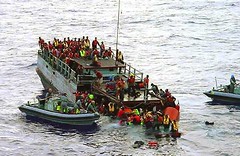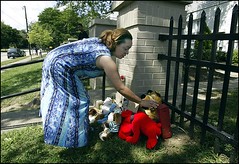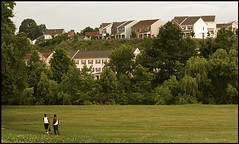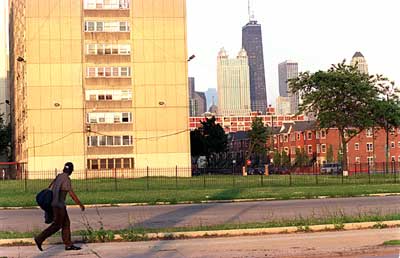In a rising real estate tide, some communities get swamped
 A metaphor for housing displacement. (Photo from the Melbourne Age.)
A metaphor for housing displacement. (Photo from the Melbourne Age.)Sunday's Boston Globe reports, "In San Francisco's shadow, a city's homicide rate soars," about a "burst of violence, including eight homicides in a two-week period last month, has plunged this beleaguered working-class San Francisco Bay community into an emotional and urgent debate about violent crime."
Hmm, sounds like Prince George's County, Maryland.
PG County is experiencing a huge increase in homicide and other violent crimes, likely due to the displacement of the poorer (and more violent among us) from DC as real estate prices continue to rise, as well as the overconcentration of lower-income demographics within particular geographies.
For more, see these articles from the Washington Post: "Slayings Surge In Prince George's: Homicide Numbers Nearing 1995 Tally," "5 Teachers Get Free Rent At Troubled Md. Complex," "The Complexities Of a Pr. George's Crime Incubator" by Courtland Milloy, and "Pr. George's Housing Called Source Of Crime: Johnson Might Raze Some Apartment Complexes."
The Gazette Newspapers, ahead of the curve in 2003, wrote about the impact of changes in Ward 7 and Ward 8 on Prince George's County, in the special report "Shouldering the Burden." (The Gazette Newspapers are owned by the Post by the way.)
 Antoinette Jefferson arranges items left by mourners where her 20-year-old son, Craig Saint Jamada, was shot to death in Seat Pleasant. Photo Credit: James A. Parcell -- The Washington Post.
Antoinette Jefferson arranges items left by mourners where her 20-year-old son, Craig Saint Jamada, was shot to death in Seat Pleasant. Photo Credit: James A. Parcell -- The Washington Post.Recognition that concentration of poverty doesn't work in terms of building stable communities led to the HOPEVI program for the revitalization of housing for residents of extreme poverty. This led to the recreation of formerly exclusively lowest-income housing into mixed-income communities. But this has come at a cost--a reduction of the total amount of housing available to those with great needs, as the reconstruction of HOPEVI communities never included an overall one-for-one replacement of lowest-income housing.
There are a number of HOPEVI examples in DC. See this recent Post article on the Wheeler Estates in Southeast DC "Door May Close on Housing Program: Renewal Uncertain for Effort That Transformed D.C. Neighborhood."
The recently launched DC Government initiative "New Communities" is, to my way of thinking, a local version of HOPEVI. The trick will be to ensure that there is one-for-one replacement of low-income housing, while adding housing for people of other incomes.
 Wheeler Creek looms above Mississippi Avenue SE. The formerly blighted area was once considered a symbol of public housing failure. (Photos By Nikki Kahn -- The Washington Post)
Wheeler Creek looms above Mississippi Avenue SE. The formerly blighted area was once considered a symbol of public housing failure. (Photos By Nikki Kahn -- The Washington Post)I think the Williams Administration deserves a lot of credit for introducing such a program in DC, to continue the idea of HOPEVI in the face of Federal cessation of the program, while improving the program for the DC context.
________
For some more reading, check out these two special reports sections from the Chicago Tribune (registration required): "Homicides in Chicago," which looks at the etiology of crime, and "A New Day at Cabrini-Green"--"Cabrini-Green is in the midst of a sweeping transformation. Its destitute high-rises are coming down and a new neighborhood is rising. In a bold social experiment, one community is being broken and another is being built. Mary Schmich spent two months reporting in this neighborhood, getting to know the people shaping the change and being shaped by it."
Also, read The Future Once Happened Here by Fred Siegel. It's at the MLK branch of the library and Second Story Books at 20th and P had a whole bunch of copies earlier in the year. Siegel just wrote a book about Rudy Guiliani, The Prince of the City. I've not read it yet.
 Cabrini-Green's high-rises loom over upscale town homes as the neighborhood undergoes a radical change. (Chicago Tribune photo by Nancy Stone)
Cabrini-Green's high-rises loom over upscale town homes as the neighborhood undergoes a radical change. (Chicago Tribune photo by Nancy Stone)



0 Comments:
Post a Comment
<< Home